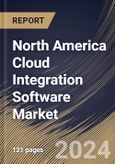Cloud integration software refers to tools and technologies designed to enable the smooth flow of data, processes, and applications between various cloud-based and on-premises systems within an organization. At its core, cloud integration aims to break down silos, ensuring seamless communication and collaboration across disparate platforms. The software acts as a bridge, connecting different cloud services, applications, and data sources, thereby optimizing overall business operations. Key functionalities of cloud integration software include data synchronization, application programming interface (API) management, workflow automation, and real-time monitoring.
The increasing utilization of cloud computing across various industries drives the market's growth. As businesses transition to the cloud, they often encounter a complex landscape of disparate applications, databases, and systems that need to share data. It enables seamless data transfer and helps businesses integrate on-premises and cloud-based applications, fostering a cohesive IT environment. Moreover, the increasing demand for scalable storage solutions significantly affects the market growth of cloud integration software. As businesses need extensive data, flexible and expandable storage capabilities become essential. The scalability offered by cloud integration allows organizations to efficiently organize and integrate large volumes of data, adapting to fluctuating storage requirements without the need for extensive on-premises infrastructure.
As of July 2022, the proportion of retail e-commerce sales to total retail sales increased from 3.9% in 2019 to 6.2%, as reported by Statistics Canada. Amid the pandemic's peak in 2020 and 2021, retail e-commerce sales constituted 6.6% and 6.9% of total sales, respectively. Many retailers operate across multiple sales channels, including online stores, mobile apps, and brick-and-mortar locations. Cloud integration enables the synchronization of product information, pricing, and inventory levels across these channels for consistency and accuracy. Thus, the above aspects will expand the market growth across the region in the upcoming years.
The US market dominated the North America Cloud Integration Software Market, By Country in 2022, and would continue to be a dominant market till 2030; thereby, achieving a market value of $2,262.6 million by 2030. The Canada market is experiencing a CAGR of 16.1% during (2023 - 2030). Additionally, The Mexico market would exhibit a CAGR of 15.1% during (2023 - 2030).
Based on Type, the market is segmented into Infrastructure as a Service (IaaS), Software as a Service (SaaS), and Platform as a Service (PaaS). Based on Enterprise Size, the market is segmented into Large Enterprises, and Small & Medium-sized Enterprises. Based on End Use, the market is segmented into IT & Telecommunication, Manufacturing, Retail & E-commerce, BFSI, Healthcare, and Others. Based on countries, the market is segmented into U.S., Mexico, Canada, and Rest of North America.
The market research report covers the analysis of key stake holders of the market. Key companies profiled in the report include Salesforce, Inc., IBM Corporation, Microsoft Corporation, Amazon Web Services, Inc. (Amazon.Com, Inc.), Citrix Systems, Inc. (Cloud Software Group, Inc.), Oracle Corporation, Informatica Inc., Verizon Communications, Inc., VMware, Inc. (Broadcom Inc.), and DXC Technology Company
Scope of the Study
Market Segments Covered in the Report:
By Type- Infrastructure as a Service (IaaS)
- Software as a Service (SaaS)
- Platform as a Service (PaaS)
- Large Enterprises
- Small & Medium-sized Enterprises
- IT & Telecommunication
- Manufacturing
- Retail & E-commerce
- BFSI
- Healthcare
- Others
- US
- Canada
- Mexico
- Rest of North America
Key Market Players
List of Companies Profiled in the Report:
- Salesforce, Inc.
- IBM Corporation
- Microsoft Corporation
- Amazon Web Services, Inc. (Amazon.Com, Inc.)
- Citrix Systems, Inc. (Cloud Software Group, Inc.)
- Oracle Corporation
- Informatica Inc.
- Verizon Communications, Inc.
- VMware, Inc. (Broadcom Inc.)
- DXC Technology Company
Unique Offerings
- Exhaustive coverage
- The highest number of Market tables and figures
- Subscription-based model available
- Guaranteed best price
- Assured post sales research support with 10% customization free
Table of Contents
Companies Mentioned
- Salesforce, Inc.
- IBM Corporation
- Microsoft Corporation
- Amazon Web Services, Inc. (Amazon.Com, Inc.)
- Citrix Systems, Inc. (Cloud Software Group, Inc.)
- Oracle Corporation
- Informatica Inc.
- Verizon Communications, Inc.
- VMware, Inc. (Broadcom Inc.)
- DXC Technology Company
Methodology

LOADING...








